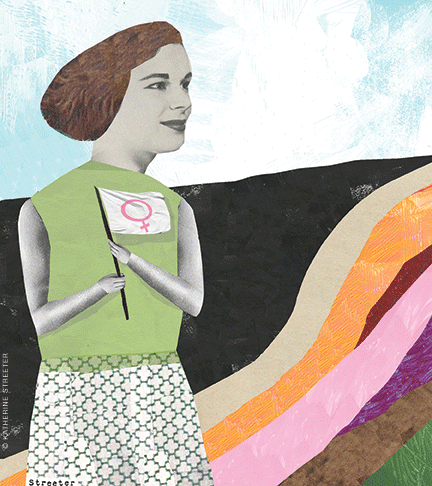Women’s Studies | Top 10 lists have become a comedy staple, but the one distributed by social ethicist Martha Nussbaum to the audience packed into 200 College Hall to hear her speak on “Gender Justice, Human Rights, and Human Capabilities” was no joke—though it could be the key to achieving happier, more satisfying lives for most of humanity.
Before delivering the 2004 Judith R. Berkowitz Endowed Lecture, which celebrated the 30th anniversary of the Women’s Studies program, Nussbaum, the Ernst Freund Distinguished Service Professor of Law and Ethics at the University of Chicago, handed out a list of 10 Central Human Capabilities—including, among others, being able to live a normal life span; to move freely, secure from violence or sexual assault; to be able to use one’s mind and express oneself freely; to be able to develop emotional attachments, unblighted by fear or anxiety; to be treated as a dignified being whose worth is equal to others; to laugh, to play; and to control one’s environment, both in terms of participating politically and being able to hold property and seek employment on an equal basis with others.
In her lecture, Nussbaum advocated the capabilities approach as an alternative method of evaluating the growth and development of nations. Because of its focus on human potential rather than on the current state of people’s lives, this approach speaks particularly to women around the world, who face obstacles that seek to prevent them from achieving their full potential.
For many years, Nussbaum explained, economic growth as measured by gross national product (GNP) was the primary goal of development. But because it doesn’t take distribution into account, the GNP approach was useless for telling us about nations with high rates of poverty and inequality.
“But it’s actually worse than useless because it gives high marks to nations that had huge inequalities, encouraging them to just focus on economic growth. South Africa under apartheid used to shoot straight to the top of the list of developing countries,” she said.
By contrast, the capabilities approach focuses on what citizens of a society are able to do and to be. The concept began to take shape when Nobel laureate Amartya Sen wrote in the first U.N. Human Development Report in 1990: “The real wealth of a nation is its people.” Sen suggested that growth is a poor indicator of quality of life “because it fails to tell us much about how the most deprived people are doing.” Added Nussbaum, who has been at the forefront of the still-developing school of thought since its inception: “Women are one group of people who often don’t get to enjoy the fruits of that prosperity.”
Indeed, a concept of human development that places emphasis on agency and freedom is of special interest to women. And while Nussbaum agrees with Sen’s basic thrust and commends him for his discussion of sex inequality, she said, he is simply not explicit enough.
That’s where the list of capabilities comes in. Nussbaum acknowledged that much of the content spelled out by the list is echoed in the language of the international human-rights movement. But, she said, there are important differences. One of the most interesting distinctions has to do with language.
The U.S. Constitution, for example, uses the concept of negative liberty to express rights. (“Congress shall make no law … ”) Using this logic, it is thought that people’s rights have been secured simply by removing interfering state action from their lives. The problem is that sometimes, without taking action to make sure people of limited means have access to these rights, they exist in theory only.
“Women in many nations have a nominal right to political participation and the state is not preventing them from having it,” Nussbaum said by way of example. “Nonetheless they really don’t have this right—for instance, they may be threatened with violence if they leave the home. Thinking in terms of capabilities gives us a benchmark to think about what it really is to make rights real.”
The constitution of India, by contrast, specifies rights affirmatively: “All citizens shall have the right to freedom of expression … ” This means that Affirmative Action-type programs to aid lower castes and women are not merely compatible with constitutional guarantees for nondiscrimination and equal protection, but are actually in their spirit. Nussbaum cited India’s recent constitutional amendments that guarantee women one-third representation on the local village councils. “Measures such as these are strongly suggested by the capabilities approach, which devises strategies for dealing with the obstacles people face.”
Another weakness of rights language, Nussbaum said, is that it can “give the illusion of agreement where there’s really deep philosophical disagreement.” The capabilities approach is not at odds with this disagreement, or with pluralism, mainly because it has built into its philosophy a separation of what Nussbaum called justification and implementation.
“I think we can justify philosophically this list as a good basis for political principles all around the world, but this of course doesn’t mean that we thereby license intervention in the affairs of a nation that doesn’t recognize them.”
Nussbaum, who has written about patriotism, cloning, sexual orientation, gender studies, and feminist studies, originally formulated the list for her first book, Cultivating Humanity: A Classical Defense of Reform in Liberal Education, which won the Ness Book Award of the Association of American Colleges and Universities. The list has undergone changes since its inception, and she said it likely will again as people respond to it. Interestingly, “justified anger,” an emotional entitlement that appears on the list today, wasn’t on the original version in 1985. Ultimately, though, Nussbaum feels that what’s crucial is not what goes on the list but that there be a list.
“Either a society has a conception of justice or it doesn’t,” she said, “but if it has one we have to know what its content is.”




